The Economic Forecast Council, 2004
Introduction
Prior to the annual budget, the Minister of Finance seeks
the advice of the Economic Forecast Council (the Council)
on the outlook for the provincial economy and presents their
forecasts with the budget. This consultation process is a
requirement of the Budget Transparency and Accountability
Act.
The Minister met with the Council on December 8, 2003
to discuss the economic outlook for 2004 and beyond.
Council members discussed their views on the international
outlook as well as the Canadian dollar. This was followed
by a discussion of the province's near-term economic outlook,
as well as factors affecting the province's medium-term outlook.
Finally, the Council discussed the impact of fiscal policy
and other issues facing the BC economy. The underlying forecast
details are summarized in the table at the end of the topic
box.
Overview
Improving North American and global economic conditions are
expected to contribute to stronger BC growth in 2004. In the
medium-term, Council members expect infrastructure construction
relating to the 2010 Olympics to result in stronger growth.
The forecasters also acknowledged the impact of policies to
attract investment, noting recent successes in the oil and
gas sector. The average of participants' forecasts was that
the British Columbia economy would post growth in 2004 of
2.9 per cent, up from 1.7 per cent in
2003, and then grow 3.2 per cent on average in 2005
through 2008.
All the participants agreed that the U.S. economy would post
stronger growth in 2004; the average outlook was 4.4 per cent.
Continued appreciation in the Canadian dollar was one of the
main concerns of Council members and was their main forecast
risk.
The Council's updated average forecast for British Columbia
growth in 2003 of 1.7 per cent was lower than the
2.7 per cent anticipated a year ago. The weaker-than-expected
growth resulted from a number of external shocks including
the rapid appreciation of the Canadian dollar, the SARS outbreak,
the war in Iraq and forest fires. Retail sales growth was
weaker in 2003, while the housing sector soared due to record
low interest rates.
International Outlook
Given the significant fiscal and monetary stimulus in the
U.S., all the Council members expected the U.S. economy to
post stronger growth in 2004. The economic recovery in the
U.S. was also expected to improve Canada's growth prospects.
However, the Council saw Canadian economic growth lagging
behind the U.S. over the forecast period.
The Council was more mixed in terms of the durability of
strong growth in the U.S. Some Council members felt that fiscal
retrenchment would weaken growth in 2005 and 2006. Others
expected U.S. growth at or above four per cent to continue
in 2005. High levels of consumer debt and slow job creation
in 2003 made consumers vulnerable, and a pick-up in business
investment will be crucial to a sustained period of economic
growth in the U.S.
Overall, the participants' forecasts on average point to
U.S. growth of 4.4 per cent in 2004 and 3.7 per cent
in 2005, before slowing to 3.2 per cent for the
2006 to 2008 period.
The Council recognized that Japan's economy performed well
in 2003, but they did not see this growth as sustainable and
expect a return to weaker growth over the medium-term. China
was mentioned by the Council as the engine of economic growth
in Asia, and it will be important for BC and Canada to gain
access to this growing market.
The Canadian Economy
In 2003, the Canadian economy grew more slowly than the U.S.
largely as a result of several external shocks. While the
economic recovery in the U.S. is expected to boost Canadian
growth, many Council members pointed out that the composition
of growth in the U.S. also matters. The sectors that use Canadian
exports heavily such as auto manufacturing and housing are
not where some members of the Council expect to see strong
growth.
The Canadian economy was forecast to grow 3.0 per cent
in 2004, strengthening to 3.2 per cent in 2005 before
returning to 3.0 per cent on average in 2006 through
2008.
The biggest concern expressed by Council members in terms
of Canadian economic growth was the rapid appreciation of
the Canadian dollar. Some members felt that the Canadian dollar
would appreciate further and that the Canadian economy will
continue to feel the impact of the appreciation that happened
in 2003, as firms and consumers adjust to the higher dollar.
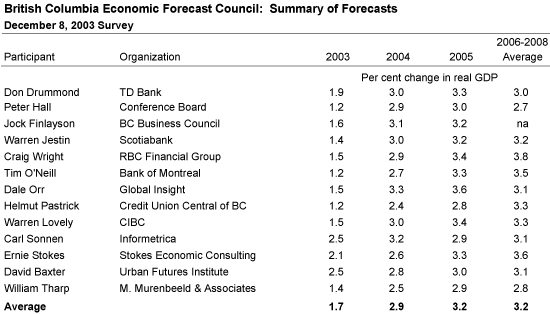
Financial Markets
Council members agreed that the record low interest rates
in the U.S. were providing stimulus to the economy and supporting
a booming housing market. The intended federal funds rate
was projected to be 1.3 per cent on average in 2004,
rising to 2.9 per cent in 2005 and 4.1 per
cent on average over the 2006 to 2008 period.
In Canada, the Bank of Canada's overnight target rate was
forecast to increase from 2.9 per cent in 2004 to
3.6 per cent in 2005. The interest rate spread with the
U.S. will continue to narrow over the medium-term with the
Bank of Canada's overnight target rate expected to average
4.4 per cent for 2006 to 2008.
The Canadian dollar was recognized by the Council as the
most significant forecast risk. The impact of the rapid appreciation
in the currency will continue to be felt this year. Exports
and tourism are negatively affected by a higher Canadian dollar,
while consumers and investors in communications equipment
and capital benefit. Some Council members expressed concern
that the Canadian dollar could overshoot into 80 cent US
territory in 2004.
The Council debated the ability of the Bank of Canada to
influence the level of the dollar. Some members pointed to
the lack of success that the Bank of Canada has had in the
past controlling the exchange rate. Some Council members felt
that the Canadian dollar would appreciate further, in the
range of another 10 per cent, while others see the
dollar returning to the low 70's over the medium-term.
The Council had divergent views on the Canadian dollar outlook.
For 2004, the range of participants' opinions was from a low
of 73.9 cents up to a high of 80.0 cents US. By
2005 half of the Council members expect the Canadian dollar
to rise vis-à-vis the U.S. dollar, while the other half see
the dollar depreciating. For the 2006 to 2008 period the Council
members outlook for the Canadian dollar ranged from 72.0 cents
to 82.0 cents US.
British Columbia Forecast
On average, participants at the Economic Forecast Council
meeting expected B.C.'s economy to grow 2.9 per cent
in 2004 and 3.2 per cent per year in 2005 through
2008. Opinions for 2004 ranged from 2.4 per cent
to 3.3 per cent. Forecasts of growth in 2004 were
fairly concentrated with nine Council members predicting growth
at or above 2.75 per cent. Several Council members
had Canada showing stronger growth than British Columbia in
2004 and 2005, while others felt that British Columbia would
do as well or outperform the country as a whole this year
and next.
Economic Forecast Council Outlook for the British Columbia
Economy
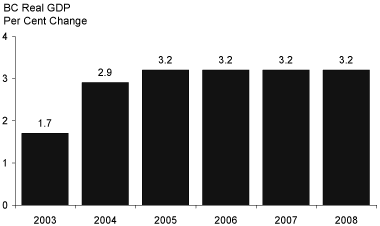
External Issues
The Council felt that the softwood lumber dispute was a significant
factor affecting the outlook for the BC economy.
In addition, many Council members noted that BC is well positioned
to benefit from China's emergence as an engine of global economic
growth. Due to geographic and market positioning considerations,
Council members were optimistic that BC can capitalize on
the opportunities provided by China's large and growing markets.
Sectoral Issues
In terms of the domestic economy the Council focused on the
outlook for the labour market, immigration and housing.
Some Council members saw a tightening of the labour market
over the next few years with industries such as construction
facing labour shortages. Promoting immigration was raised
as a possible solution to labour shortages. However, Council
members noted that BC must compete with other provinces for
skilled immigrants and that several administrative barriers
exist, resulting in Canadian immigration targets not being
achieved and skilled immigrants being under utilized in the
workforce. The Council expected BC's net migration to average
24,720 people in 2004, opinions ranged from a low of
12,700 people to a high of 33,000 people.
Economic Growth Forecasts, 2004
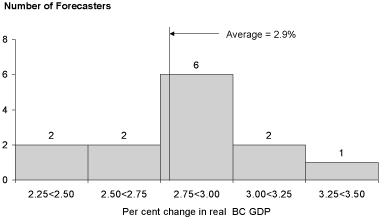
Economic Growth Forecasts, 2005
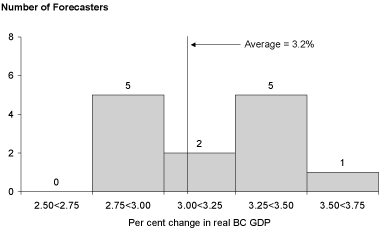
The housing sector has been an area of strength in the BC
economy over the past year. Some Council members felt that
housing construction is not sustainable at current levels
and would undergo a correction, due to market saturation,
pre-emptive building and affordability issues. For 2004, the
Council's outlook for housing starts ranged from 20,000 to 29,000 units
with an average of 25,565 units.
Several Council members noted that international security
concerns have hindered the tourism sector in BC and Canada.
It is difficult to isolate the impact of heightened security
concerns in the U.S. as a number of other shocks experienced
by the economy have also been detrimental to tourism, such
as the SARS outbreak, the weak U.S. economy and the higher
Canadian dollar.
Government
Council members commented on the government's three-year
plan and recommended staying the course, in particular the
legislated commitment to balance the budget starting in 2004/05.
In reference to the energy sector, the Council noted that
BC's "open for business" climate had been well received. Energy
was seen to be a bright spot in the BC economy and demand
from the U.S. is expected to continue to strengthen. Council
members expect U.S. demand for natural gas to rise as more
industries and consumers move away from coal and other energy
sources towards natural gas.
Most participants agreed that an increase in business investment
was needed to put the province on a faster growth path.
Risks to the Outlook
The Council discussed the risks to the outlook for the British
Columbia economy. The major risk was a further appreciation
in the Canadian dollar, which could dampen growth prospects.
On the upside, a possible resolution to the softwood lumber
dispute would provide certainty for the forest industry and
encourage investment, boosting economic growth in BC. The
Kyoto Protocol was recognized as a potential issue in the
outlook although the implications were unclear. The ability
of BC to attract skilled immigrants and realize their full
potential in the labour force will be a key issue in achieving
the workforce skills required to sustain economic growth.
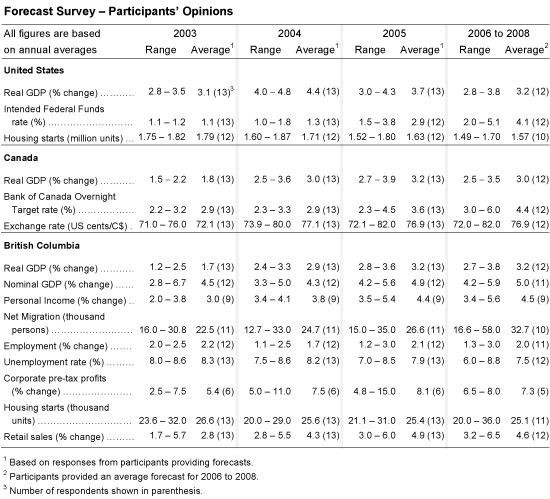
|
